With over 30 years of experience working with hundreds of athletes, here are my 5 tips for running a successful speed session.
#1 Warm Up for the Day
It is important to make sure athletes are warmed up in all planes of motion and levels for each workout. If you really want to optimize the workout, put an emphasis on warming up patterns similar to how the athletes will be asked to train today. For example: When primarily focusing on a lateral day, the warm-up should have lots of focus on abduction, adduction, internal and external rotation, pronation, supination, and frontal plane core warm-up to name a few. Make sure you do sagittal plane work, but it is a MUST to hit the parts of the body that are being called into action the most.
#2 Get a Reaction
Sorry! We are doing it wrong. The profession is missing this all-important factor about the nervous system and the engagement of the athletes. Athletes want to compete. This is ultimately why they come to us, to play sports and to get better at them. I start all workouts out, after the warm up, with a Tier 1, Tier 2, or Tier 3 Reactive Speed Pattern.
These simply mean the athletes are going to reactive to either a coach’s command, a partner’s action, or a signal. This instantly puts the athletes in a state of mind to move with urgency. Even if the drill is not designed for 100% effort. Plus, we see what kind of movers we have on this day. The athletes might be sluggish, out of sync, stiff in the hips, etc. By making them react we can quickly see compensations or pattern dysfunction and know exactly what to address that day.
#3 Plan a Path for Correctives
Tip #2 made it clear that we need the Reactive Tier System to immediately get our athletes in a fired-up state of mind and assess their movement quality for the day. If we take our job seriously, then we have already planned the workout and have the patterns we will be teaching for the day down.
This means we should have a list of correctives we will use to “fix” the dysfunctional patters, or at least reinforce the good patterns. For example: If today is a short linear acceleration day, then the athletes will perform a Tier 1 reactive drill. We might see poor knee and arm drive, poor posture, and maybe a group of athlete lacking hard “pushing/drive”, therefore we will have correctives that will work on knee and arm drive, posture, and we can implement band resisted acceleration to force greater pushing down and back. Therefore, the athletes needing the correctives will be assigned proper “corrections” while the athletes performing well, will be assigned greater repetitions and reinforced patterning. It is kind of like being a 94% foul shooter, but still needing to practice every day.
#4 Spend Most of Your Time Coaching Effort
Assuming you want your athletes to have success with speed training, then they must show great effort all the time or the skills will look less than optimal. Effort improves posture used to drive down and back during acceleration, or straight down to jump vertically. Effort can clean up poor pattern simply because action reaction forces are improved, and positive lines of power are now generated. Effort is key!
#5 Drive Patterns or Actions Through Drills You Choose
If you want to see an action such as a Plyo Step, Hip Turn, Directional Step, or Glide Step, then the key is to drive these patterns or actions through the drills you choose. Do not become too wordy and try to teach these patterns. Simply, force the athlete to perform the skill based on the drill used.
For example: When you want the athlete to perform a Hip Turn, stand behind the athlete and ask them to get into an athletic stance. On the word “GO”, the athlete turns around and attempts to catch the tennis ball you drop by your side before it bounces two times. This is an example of a Tier-1 Reactive Drill. It forces a fight or flight response to escape the current space the athlete is occupying and start accelerating. If you want to have the athlete work on the Direction Step, simply practice a base stealing action. Just make they go hard, and the pattern will solidify.
Summary
Whenever athletes have major dysfunction during speed pattern execution, you simply start with the whole skill and slowly peel away one layer at a time with correctives, trying to stay as close to the whole skill as possible, until you find a corrective that scratches the itch.
We don’t progress multi-directional speed, we regress it when correcting it. Always start and end with the whole to be fair and consistent with the nervous system motor programming of that skill.
Be an Ambassador of Speed

